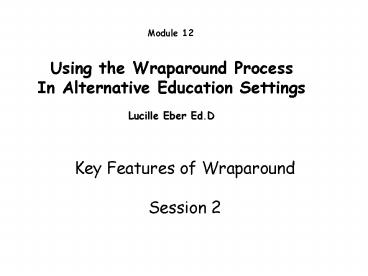Key Features of Wraparound - PowerPoint PPT Presentation
1 / 14
Title:
Key Features of Wraparound
Description:
The Art & Science of Wraparound. Eber, 2003. What happens during the ... The Art & Science of ... interests and skills with bicycles (actually, he had a ... – PowerPoint PPT presentation
Number of Views:169
Avg rating:3.0/5.0
Title: Key Features of Wraparound
1
Module 12 Using the Wraparound Process In
Alternative Education Settings Lucille Eber Ed.D
Key Features of Wraparound Session 2
2
Key Features of Wraparound
- community-based natural environments
- uses an individualized team process for
individual students - built upon youth and family unique strengths
needs - culturally relevant teams and plans address
multiple life domains - plans reflect voice, priorities of youth and
family - team involves family, natural supports, community
supports - resources are blended must be flexible
- uses traditional and non-traditional
interventions - services are planned, implemented, and evaluated
by a team - team supports youth, family and providers
- unconditional - if the plan doesnt work, change
the plan - interagency collaborative process
- Outcomes monitored through team process
See handout 2.1
3
Life Domains
Family,
School,
Community
- Medical/Health
- Recreational
- Education/Vocational
- Spiritual
- Cultural
- Social/Fun
- Safety
- Emotional/behavioral
- Basic Needs
- Legal
- Relationships
- Other
4
How are strengths used continuously in the
wraparound process?
- To engage team members
- To establish ownership of team and plan
- To ensure ownership in interventions
- To ensure interventions are proactive
- To continuously build on successes
The Art Science of Wraparound Eber, 2003
5
Unique Fit
- Wraparound plans should be uniquely designed to
fit individual students needs as opposed to
making a student fit into a prescribed program.
The Art Science of Wraparound Eber, 2003
6
A Definition of Unconditional Care
- Students dont fail plans fail.
- When the plan fails, dont blame the
youth/family. - Instead, change the plan.
The Art Science of Wraparound Eber, 2003
7
What happens during the wraparound process?
- Blending perspectives of team
- members results in a variety of
- traditional and nontraditional strategies
- that are directly linked to agreed
- upon outcomes.
The Art Science of Wraparound Eber, 2003
8
What happens during the wraparound process?
- The wraparound process creates a context for
effective implementation of research-based
behavioral, academic and clinical interventions
The Art Science of Wraparound Eber, 2003
9
Ownership Voice
The person who is supposed to implement the
strategy needs to be actively involved in
designing it or it probably wont work!
The Art Science of Wraparound Eber, 2003
10
How are wrap teams different?
- Roles are the focus (not job titles)
- Natural supports
- Focus on strengths
- Family voice and ownership
- Focus on needs (instead of services)
The Art Science of Wraparound Eber, 2003
11
Similarities with Processes used in Special
Education
- Person-centered planning
- Positive behavior supports
- Mapping
- IFSP
- Voice and choice re quality of life
- Collaborative team process
- Supports adults who provide interventions for
child - Focus on natural supports settings
- Multiple life domains
The Art Science of Wraparound Eber, 2003
12
Building Capacity for Natural Supports
- A student who had strong interests and skills
with bicycles (actually, he had a history of
stealing bikes, rebuilding them and selling them)
was connected with the owner of a local bike shop
who hired him to work there and, over time agreed
to be a team member.
13
- Examples of Roles a
- Teacher could Provide
- Academic Coach
- Behavioral Coach
- Friend
- Crisis support
- Respite provide
- Translator
The Art Science of Wraparound Eber, 2003
14
Examples of Natural Support People who have been
on teams
- Colleagues
- Friends
- Extended Family
- Neighbors
- Coaches
- Clergy
- Bus Drivers
- Babysitters
- School Custodian
- Crossing Guard
- Classmates
The Art Science of Wraparound Eber, 2003































